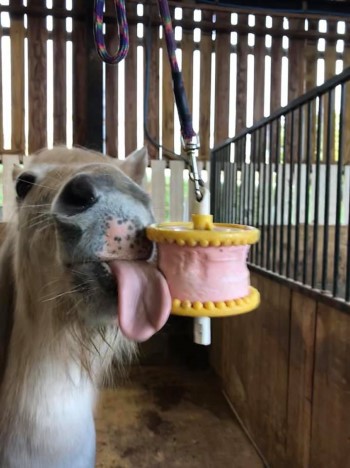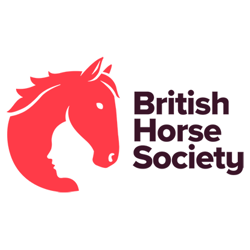Why do horses need enrichment?
As herd animals, horses prefer to live in social groups, which provides them with the opportunity for interactions such as mutual grooming and play which is particularly beneficial for younger horses. Movement is important to horses, and in the wild they may travel between 8 to 23 kilometres daily1. Naturally horses have a forage-based diet and will graze and browse for up to 16-18 hours a day, an activity that isn’t only instinctive but also promotes good gut health. This lifestyle is essential for their wellbeing, reflecting their need for friends, forage and freedom2.
Horses may have to be stabled, and potentially for longer periods, for a variety of reasons. This could be for box rest or having to keep horses on very restricted grazing, for example during the winter months, which presents a different environment compared to being turned out including:
- Lack of interaction with other horses
- Lack of opportunity for mutual grooming
- Significant decrease in movement
- Feed may be consumed quicker (particularly bucket feed)
- Decreased foraging and browsing opportunities
- Potentially long periods of time without food.
When there’s a change in management, horses can all react differently to their surroundings. Some horses adapt comfortably, while others can become stressed. Regardless of what facilities you have available and the type of horse, there are steps you can take to improve enrichment.
Optimising basic management
Regardless of how you keep your horse (stabled, living out or a combination) it’s vital that you meet your horse’s basic needs. A good way to remember these needs is the BHS guiding principles. Failure to meet these needs will cause your horse stress and reduce their welfare3.

While providing these basic needs shouldn’t be viewed as enrichment for horses, there are ways that we can enhance how we deliver these needs to provide horses with enrichment both in the stable and field.
Types of enrichment
There are different categories of enrichment options available which will provide horses with more varied opportunities to express their natural behaviours.
Social
chevron-down
chevron-up
Whether kept stabled, in a field or using alternative keeping methods, horses must be allowed to see and engage with their friends to allow for grooming, sleeping, grazing and playing. Ideally, this would be with other horses or donkeys, but horses can benefit from interaction with other species and humans.
Physical
chevron-down
chevron-up
Horses naturally thrive in environments that offer a variety of physical and structural features. Owners can simulate these natural conditions by including similar elements into the horse's living space, providing an enriched and more familiar setting for the animal. This approach helps in creating an environment that resembles their natural surroundings and supports their wellbeing. Examples of how you can provide this include:
- Providing more than one food/water source
- Providing various types of terrain
- Feeding varied types of forage
- Shelter (natural or constructed).
Nutritional
chevron-down
chevron-up
Horses have adapted over time to browse and chew for 18 hours a day, making it essential for them to have regular access to forage. This trickle-grazing approach is crucial for their health and wellbeing, but can cause excess weight gain in some horses. Using enrichment tools can slow your horses eating down which allows them to display natural behaviours and for their forage to last longer. In addition to this, there are numerous methods available to stimulate their taste buds and keep their minds active using food both in the stable and field. These methods contribute to their overall quality of life and should be considered an important aspect of their care.
Sensory
chevron-down
chevron-up
Sensory enrichment engages horses’ senses of sight, sound, touch and smell.
Visual enrichment (sight) involves maintaining clear sight lines to other horses and introducing items like stable mirrors to their environment for stimulation. Horses will continually scan the horizon in the wild to engage with their environment, so changing things they can see can provide stimulation.
Olfactory enrichment (smell) is crucial as horses rely on smell to decide what to eat, detect potential dangers, find their young, friends or a mate. Incorporating horse-safe herbs such as comfrey, valerian, rosemary, meadowsweet, mint, thyme, dandelion and garlic in their forage can provide a rich sensory experience. Adding fragrant spices or scents such as citrus fruit zest, garlic or ginger to a bucket or mat can also stimulate your horse’s sense of smell.
- When introducing smells, make sure this is only done outdoors, where the horse has space to move away if they choose, and away from their food and water
- If competing, check your governing body's rules regarding Clean Sport, for example specific food and herbs to avoid
- Avoid using essential oils near pregnant mares.
Tactile enrichment (touch), such as grooming or gentle massage promotes social bonds and relaxation. Use different types of brushes on different areas of your horse to find what they enjoy most. It’s important to remember some horses will enjoy this more than others.
Providing safe objects such as old brush heads or grooming brushes for scratching or for play can also provide stimulation.
Auditory enrichment (sound), like playing music at low volumes, can be soothing, but it's important to observe the horses’ reactions as their preferences may differ from humans.
Introducing new enrichment
When introducing new enrichment to your horse, it’s important to take your time and make any changes gradually to ensure their happiness and safety.
Food-based enrichment
chevron-down
chevron-up
With any food-based enrichment, check the sugar levels, especially for horses prone to laminitis or who are overweight. For example, licks may have to be used in moderation as it’s been known for some horses to devour a whole one overnight! Any food given should count as part of their daily ration.
- Introduce any new food gradually over a minimum of 14 days to decrease the risk of colic
- If your horse is on a restricted diet, using different ways to slow down the rate of consumption will help your horse’s ration last longer therefore keeping them occupied for longer4.
New enrichment items
chevron-down
chevron-up
Introduce new enrichment items carefully, especially for horses that are naturally more worried or nervous. It’s important to keep a balance so you inspire your horse’s curiosity but don’t overwhelm them or cause unintentional stress and anxiety.
Some items can cause frustration, so should be introduced to the horse correctly so they understand what they need to do.
Environment
chevron-down
chevron-up
It’s vital to make sure that any enrichment is provided in an appropriate environment.
- Introduce new items outside of the stable for example in an arena, so the horse feels confident to approach, smell, touch and move the item in an area they know they can ‘escape’ from if worried, rather than ‘trapped’ inside the stable with the item
- When introducing things that roll, for example a hay or treat ball, make sure that it can’t roll out of reach (under a fence or door) and make sure your horse is supervised when first using the item
- Be aware how nearby horses may react to the addition of new items as it can cause them stress or frustration.
- Make sure you follow good biosecurity practices:
- Thoroughly clean any new items before giving them to your horse
- Avoid sharing licks between horses.

Photo Credit - The Mare and Foal Sanctuary
References
- Hampson et al. (2010) Distances travelled by feral horses in ‘outback’ Australia. Equine Veterinary Journal. 42, s38, p. 582-586.
- Brolin (2022). The Importance of Natural Feeding Behaviour for Horse (Equus caballus) Welfare.
- Krueger et al. (2021). Basic needs in horses?—a literature review. Animals, 11(6), 1798.
- Seabra, J. C., et al (2023). Effects of Different Hay Feeders, Availability of Roughage on Abnormal Behaviors and Cortisol Circadian Rhythm in Horses Kept in Dry Lots. Journal of Equine Veterinary Science, 130, 104911.
Thanks to Rosa Verwijs, Certified Horse Behaviour Consultant for her assistance with types of enrichment.



